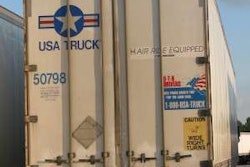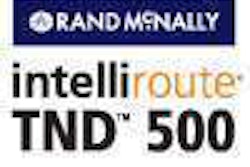 A customer calls to have an order picked up. Someone enters the order, dispatches a driver, answers calls to update load status, gathers trip documents and prepares invoices.
A customer calls to have an order picked up. Someone enters the order, dispatches a driver, answers calls to update load status, gathers trip documents and prepares invoices.
For many years, carriers have automated these and other routine transactions with electronic data interchange (EDI), a costly and complex information exchange between carriers and customers.
Traditionally, shippers and carriers have used a mailbox approach to share data. A third-party value added network (VAN) manages the mailbox to ensure the exchange is reliable and consistent. Carriers pay a monthly transaction fee based on the “kilo-characters” of data that passes through the VAN.
About two years ago, Cardinal Logistics was spending $35,000 per month in VAN charges and $13,000 for one customer alone. Today, the 1,500- truck fleet has quadrupled the volume of EDI but spends virtually nothing.
“Unless a customer absolutely requires it, we no longer use VANs,” says Clay Holmes, chief information officer of the Concord, N.C.-based third-party logistics provider.
As fleets look to cut costs during a slow economy, the systems and services used for e-commerce may be ripe with opportunities, especially when considering that volume will continue to grow as the business environment improves.
Removing the VAN
The dispatch, accounting and enterprise management systems used by carriers can read and write data in various formats. The most common format for sharing data from these systems with customers are text or “flat” files. Other formats include CSV, HTML and XML.
To communicate with external systems, shippers and carriers typically convert their data to a “standard” EDI text file, or form. The EDI forms used most often by carriers are the 204 (load tender), 210 (invoice) and 214 (status update). Even with these standard forms, many shippers require carriers to customize some elements, such as using a special code for a store number or accessorial charge.
Carriers commonly outsource this data conversion process, called mapping, to VANs. Carriers also have outsourced the testing and validation process to set up EDI with a customer.
McLeod Software offers an EDI engine for its LoadMaster Enterprise software system that converts data from LoadMaster to EDI automatically. The engine will adapt data in LoadMaster to match any special codes or unique formatting required by shippers.
McLeod already has developed many of the “maps” for converting data in LoadMaster to the various EDI forms used by shippers. Carriers can purchase these maps for a low cost, and LoadMaster customers can connect directly with shippers without using a VAN or software from a third party.
“We are seeing more and more carriers going direct (with customers),” says Tom McLeod, president.
Fleets can establish direct, secure connections with customers through the Internet without incurring VAN charges. The most popular protocols for exchanging EDI through the Internet are AS2 and Secure FTP, McLeod says. Despite these new technologies, many shippers still require carriers to use VANs because they already have established partnerships.
Even if a shipper does not mandate the use of a VAN, carriers may prefer to use them to have multiple options for connectivity. Descartes Systems’ Global Logistics Network (GLN) supports traditional EDI and various other levels of technology capability. “We call it high-, low- and no-tech application functionality,” says Cindy Yamamoto, senior vice president of supply chain execution solutions.
Carriers that have advanced technology capabilities use the GLN to connect to their trading partners through EDI. Carriers not capable of handling EDI can use Descartes’ GLN to automatically convert incoming EDI forms, such as a load tender, to e-mail. The carrier then can accept loads electronically by clicking on a link in the e-mail, as well as update the load’s status electronically via e-mail or from a driver’s mobile phone.
Carriers that use GLN pay a transaction charge, but for smaller fleets, Yamamoto says this low cost of entry for EDI is preferable to purchasing software and paying for setup costs.
Doing it yourself
If you use EDI for only a small group of customers, purchasing software and staffing people to do EDI mapping is not worth the cost, says Dan McKinnon, vice president of information systems for Perkins Logistics, a 350- truck fleet based in Noblesville, Ind.
Because EDI represents a significant portion of its business, Perkins Logistics uses a software program called ProEDI to convert the data from the XML format used by its TMWSuite enterprise software system to EDI, and vice versa. Setting up EDI for a new customer can take a full day of work, so it is important to take that into account when pricing freight, McKinnon says.
About two years ago, Cardinal Logistics began eliminating VAN charges by using Microsoft’s BizTalk software. Customers put EDI forms or files they wish to exchange with Cardinal Logistics into the carrier’s FTP site. BizTalk picks up these files and converts them to the XML standard used by Cardinal Logistics’ dispatch software and other information systems.
When a customer sends an EDI load tender (form 204), BizTalk converts the EDI file to XML and automatically creates an order. Cardinal Logistics uses BizTalk to convert more than just standard EDI files; if a customer wants to send its load tenders in an Excel spreadsheet, BizTalk will convert the file into XML so the orders can be entered automatically.
Similarly, Cardinal Logistics uses BizTalk to extract and convert the data in its information systems from XML to whatever format the customer requires. The software uses Secure FTP and AS2 for reliable communications.
“(BizTalk) is like an interpreter that speaks every single language,” Holmes says.
Third-party conversion
Even mid- and large-size carriers may decide that purchasing software and using IT resources to manage EDI is not worth the time and cost. Increasingly, fleets have more options to eliminate VAN charges as well as internal costs associated with EDI.
Riverside Transport Inc., a Kansas City, Kan.-based truckload carrier, recently lowered its EDI costs by more than 40 percent by eliminating VAN charges. Previously, the 400-truck company used a combination of in-house software and a VAN to do its EDI mapping.
Today, RTI uses DiamondMine EDI translation software from Intelek. DiamondMine EDI is provided by Intelek as a Software-as-a-Service (SaaS) solution. The software is hosted on an IBM iSeries platform from Intelek and is accessible to RTI over the Internet. The product allows the carrier to communicate electronically with its shippers to transfer loads, shipment status records, invoices and electronic payments. As part of the SaaS arrangement, Intelek handles all of RTI’s EDI mapping, translation and transmission necessary to connect directly with customers.
Rather than charge a character-based transaction fee, Intelek charges a monthly subscription fee based on the number of active trucks a client operates. This arrangement enables Intelek to provide the same EDI capabilities to a one-truck carrier as it does to a large carrier. The SaaS offering supports all types of Internet-based transmissions, including AS2 and Secure FTP. “We are giving carriers the opportunity to have choice,” says Ron White, chief executive officer of Intelek.
Tranztech Solutions offers EDI mapping as a service with its Tranzactor EDI software. Once carriers purchase the base software package, they can buy individual maps that match each customer’s EDI requirements for a one-time flat fee. If the shipper wants to change an EDI form, Tranztech will update the map at no extra cost.
By eliminating VAN charges and paying a flat fee for EDI maps, carriers typically are able to achieve a return on investment from Tranztech within six to eight months, says Toby Miller, president of Tranztech.
Screen scraping for loads
Even with the latest technologies and services available, a growing number of shippers and third-party logistics firms have supplemented and even replaced their EDI processes with carrier Web portals.
Sometimes, carriers that use EDI with a customer find themselves visiting one or more shipper websites manually throughout the day to find loads, update shipment status, send invoices and input other data. Some companies have developed software that can log in to these secure sites automatically at regular intervals to manage these routine tasks.
G&P Trucking, a 500-truck carrier based in Gaston, S.C., uses Internet Data Interchange from EBE Technologies to update its customers’ websites automatically. The software can populate individual websites with data from the company’s information systems. The system also can be used to extract data, such as load offers, and accept them automatically.
Before using Internet Data Interchange, G&P Trucking was spending four to six hours each day on just one customer website. “We do use EDI with a lot of customers, but the ones that are creating headaches are the ones that do EDI and still require website updates,” says Clifton Parker, president of G&P Trucking.
Two years ago, Intelek released a screen-scraping tool called StripMiner. Fleets can set up business rules and criteria in StripMiner for the loads they wish to find. Criteria include — but are not limited to — rate, length of haul, origin and destination. When StripMiner finds loads that meet some or all of the criteria, a load offer enters into a carrier’s dispatch software system just like an EDI 204 transaction.
StripMiner integrates with Intelek’s DiamondMine EDI and other EDI translation software to process data, track loads and communicate directly with carriers’ enterprise software, the company says.
For years, carriers have been driven to adopt EDI and other forms of e-commerce by their customers. New technologies and services not only help lower the cost of meeting these customer requirements — they also are helping fleets make electronic commerce part of their competitive edge.












